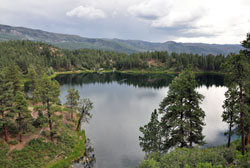Vacation / Travel Supplement
Go west!: Discover historic Durango and Silverton nestled in Colorado’s mountains

Clouds roll in over mountains and a lake along the scenic route of the Durango and Silverton Narrow Gauge Railroad train ride to and from the former mining towns in southwestern Colorado. (Photo by Mary Ann Wyand)
By Mary Ann Wyand
SOUTHWESTERN COLORADO—You may have vacationed in Denver, but have you ever visited Durango?
If not, catch a commuter flight from the Mile High City to historic Durango for a memorable western-themed vacation in the incredible Rocky Mountains.
There are lots of things to do and see all year long in scenic Durango as well as at nearby Vallecito Lake, which is 8,000 feet above sea level, and in the massive San Juan National Forest.
While staying in Durango, you can enjoy a spectacular side trip in a historic, steam-powered train on the narrow-gauge rails—clickety-clack, clickety-clack—that are nailed into the rock faces up the mountain range to Silverton.
Or you can drive to that colorful Wild West mining town along the
breathtakingly beautiful “Million Dollar Highway” carved into the mountainsides.
Telluride, Purgatory, Wolf Creek and several other popular ski resorts are nearby, but the region is best suited for a variety of summer recreational activities.
Longtime resident Suzanne Gamble likes to say that, “You can do anything that ends with an ‘ing’ in Durango.”
That would include hiking, mountain climbing and skiing, of course, as well as gliding, camping, hunting, horseback riding, whitewater rafting, boating, fishing, swimming, cycling, shopping and sightseeing.
In the Rocky Mountains, bears, cougars, wolves, moose, elk and deer roam free. Sometimes bears visit the garbage cans in Durango at night, and make quite a racket as they forage for leftover food. Residents keep their windows closed and locked after dark for obvious reasons.
Downtown Durango’s historic sites draw plenty of tourists interested in days gone by when customs were less civilized.
The Durango and Silverton Narrow Gauge Railroad Train Depot and Museum are fun to visit, and the gift shop offers a variety of unique, rail-themed gifts ranging from educational books to
T-shirts, sweatshirts and boxer shorts decorated with steam locomotives and the words “toot toot.” Purdue Boilermakers fans will love them.
But your visit to the depot isn’t complete unless you take the train up the mountain to Silverton. En route, you can watch for bears. You rarely see cougars, even while hiking, but they see you.
Ray Mayer, a Durango and Silverton Narrow Gauge Railroad Museum volunteer for 12 years, said four locomotives transport tourists up and down the mountains.
“The largest locomotive holds eight tons of coal and burns about six tons during the whole trip,” Mayer explained during a presentation at the train depot.
“It carries 5,000 gallons of water, which is about 20 tons,” he said. “The engineer stops to fill the water tank twice going up and once coming back. Fully loaded, it weights close to 130 tons.
“The rides have been offered as a tourist railroad since the mid-1940s and 50s,” Mayer said, “but the main purpose of the original railroad—when it was the Denver and Rio Grande Railway—was for carrying gold and silver mined in the mountains.”
The stately Strater Hotel, a National Historic Landmark, has welcomed travelers since 1887, and the ornate Diamond Belle Saloon there offers a trendy, tasty menu served by waitresses dressed as barmaids in fancy, slightly scanty and brightly colored
“can-can” costumes.
Tourists will enjoy authentic looking
re-enactments of a Wild West shootout several times a week in front of the ornate Victorian hotel—just like those depicted in cowboy movies.
A museum in the nearby town of Animas still proudly promotes its claim to fame—the city marshal shot the county sheriff in a dispute over gambling on Jan. 9, 1906, which permanently ended their feud.
Durango now boasts an artist’s colony, and stores display a variety of handmade items that include silver jewelry, which is an appropriate purchase in Colorado mining country.
The town’s Old World hospitality and Old West traditions are evidence that Durango residents appreciate the tourism industry.
Up the mountainside, Silverton’s streets are dirt and the train engine steams right up the middle of a dusty side street near the restored shops, restaurants and The Grand, an ornate Victorian hotel complete with Grumpy’s Saloon, built in 1882.
Tasty barbecue sandwiches and freshly brewed beer at the Silverton Brewery add to the ambience of this isolated mining town, where the residents who rely on tourism often get “snowed in” during major winter storms.
After the morning and afternoon trains depart, Silverton residents pretty much close up shop and go about their personal business. Motorists who arrive there too late in the day may find a lot of locked stores, which was surprising.
Silverton’s sometimes deserted streets add to the feel of yesteryear, and you can imagine a cowboy greeting you with “Howdy, pardner!”
The old jail there is now a museum, and visitors can explore the heavily reinforced brick building with thick steel bars on every window to keep gangs of outlaws on horses from breaking in with guns blazing to rescue bandit friends in days gone by.
But it’s Durango—tamer than it was in yesteryear, but still rugged—that captures your heart.
John Gamble, a former mayor of Durango, and his wife, Suzanne, moved to southwestern Colorado in 1983, and love the variety of recreational, cultural and social opportunities there.
“It’s an old western mining town, a wonderful community filled with interesting and dynamic people,” he said. “You can stay here a month and never eat at the same restaurant. It’s a great place to live and a great place to visit.” †
